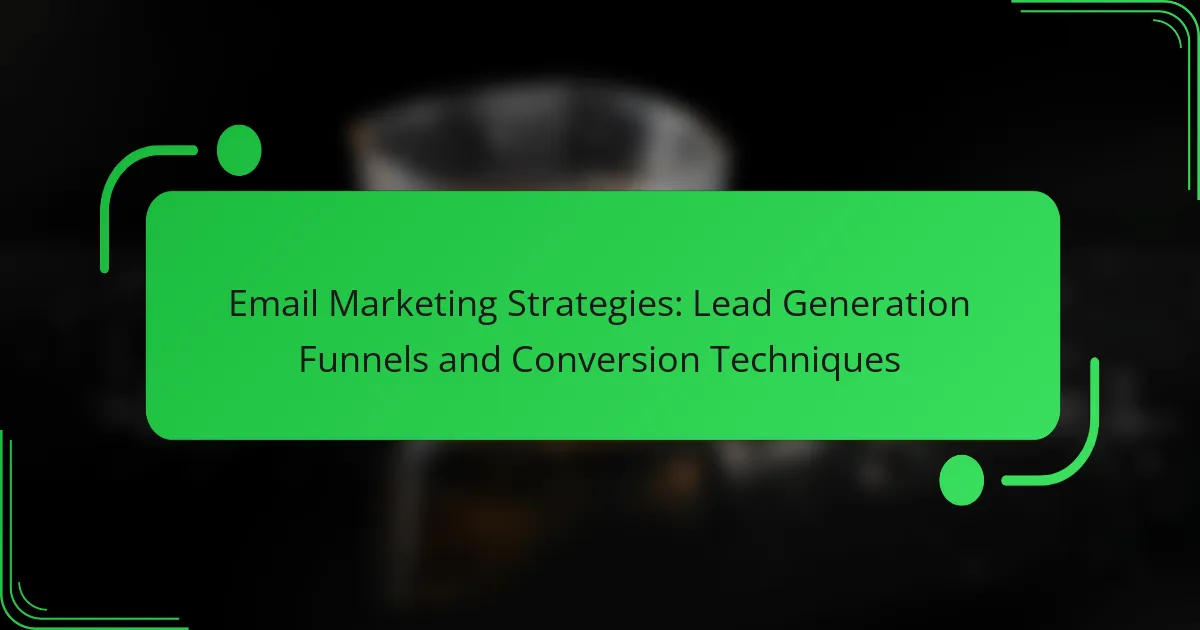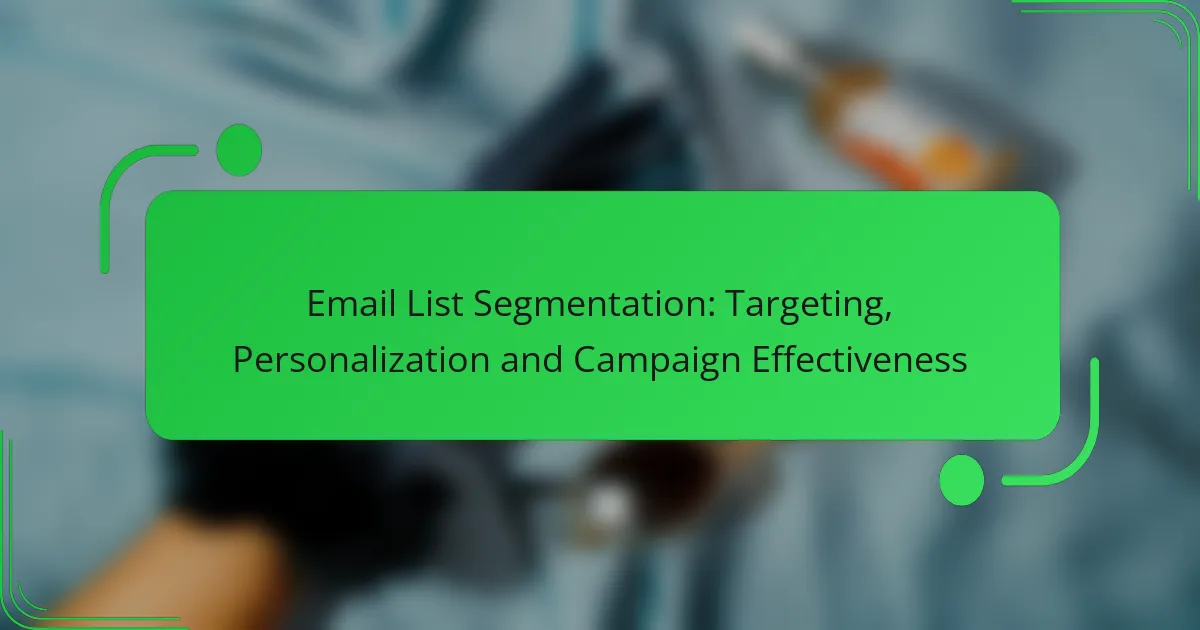Email marketing strategies for lead generation are essential for engaging potential customers and guiding them through the sales funnel. By creating targeted lead generation funnels and employing effective conversion techniques, businesses can enhance their conversion rates and foster long-term customer relationships.
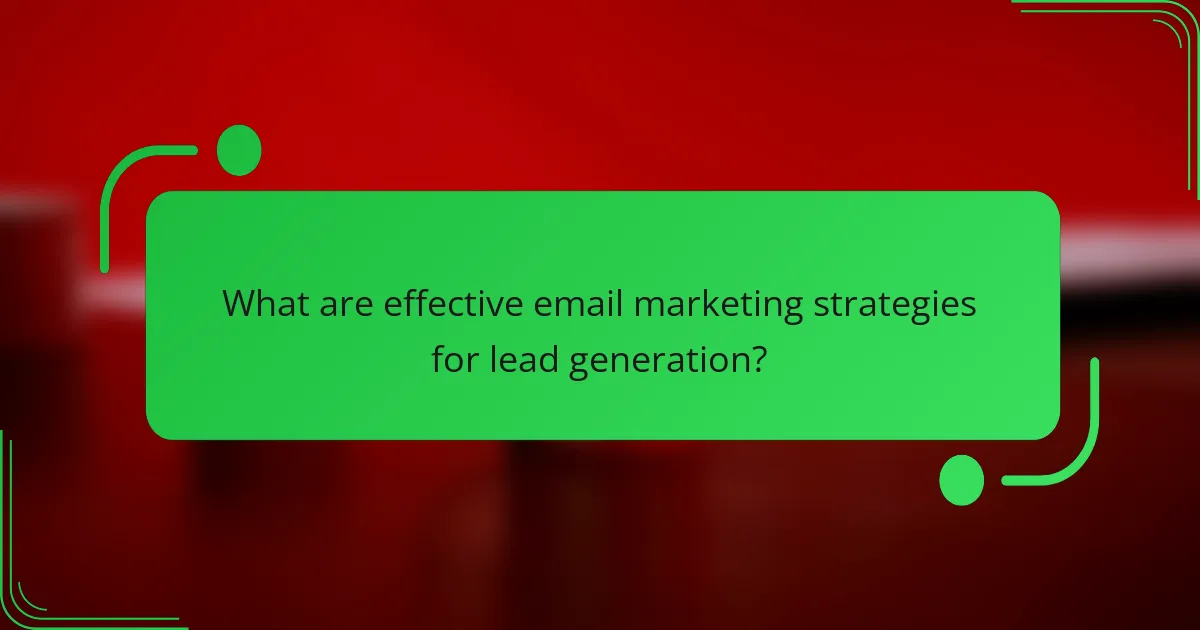
What are effective email marketing strategies for lead generation?
Effective email marketing strategies for lead generation focus on engaging potential customers and nurturing them through the sales funnel. By employing targeted techniques, businesses can increase their conversion rates and build lasting customer relationships.
Segmented email campaigns
Segmented email campaigns involve dividing your email list into smaller groups based on specific criteria such as demographics, behavior, or purchase history. This allows for tailored messaging that resonates more with each segment, increasing engagement and conversion rates.
To implement segmentation, analyze your existing data and identify key characteristics that differentiate your audience. For example, you might create segments for new subscribers, loyal customers, and inactive users, each receiving customized content that speaks to their unique needs.
Personalized content
Personalized content enhances the relevance of your emails by addressing recipients by name and offering tailored recommendations based on their preferences or past interactions. This approach fosters a stronger connection and encourages recipients to take action.
Utilize data from previous purchases or browsing behavior to suggest products or services that align with individual interests. For instance, if a customer frequently buys fitness gear, recommend related items or exclusive discounts on new arrivals in that category.
Automated follow-ups
Automated follow-ups are a crucial strategy for maintaining engagement with leads who have shown interest but haven’t converted yet. By setting up automated email sequences, you can nurture these leads over time without manual intervention.
Consider creating a series of emails that provide valuable content, such as tips or case studies, followed by a gentle reminder to revisit your offerings. Tools like Mailchimp or HubSpot can help you set up these automated workflows effectively.
Engaging subject lines
Engaging subject lines are essential for improving open rates and capturing the attention of your audience. A compelling subject line should be concise, intriguing, and relevant to the content of the email.
Experiment with different styles, such as asking questions, using numbers, or creating urgency. For example, “Unlock 20% Off Your Next Purchase!” or “Are You Ready to Transform Your Fitness Routine?” can entice recipients to open your emails.
Clear calls to action
Clear calls to action (CTAs) guide your audience on what to do next, whether it’s signing up for a webinar, downloading a resource, or making a purchase. Effective CTAs should be prominent, actionable, and easy to understand.
Use contrasting colors and concise language to make your CTAs stand out. Phrases like “Get Started Now” or “Claim Your Free Trial” create a sense of urgency and encourage immediate action, ultimately driving conversions.
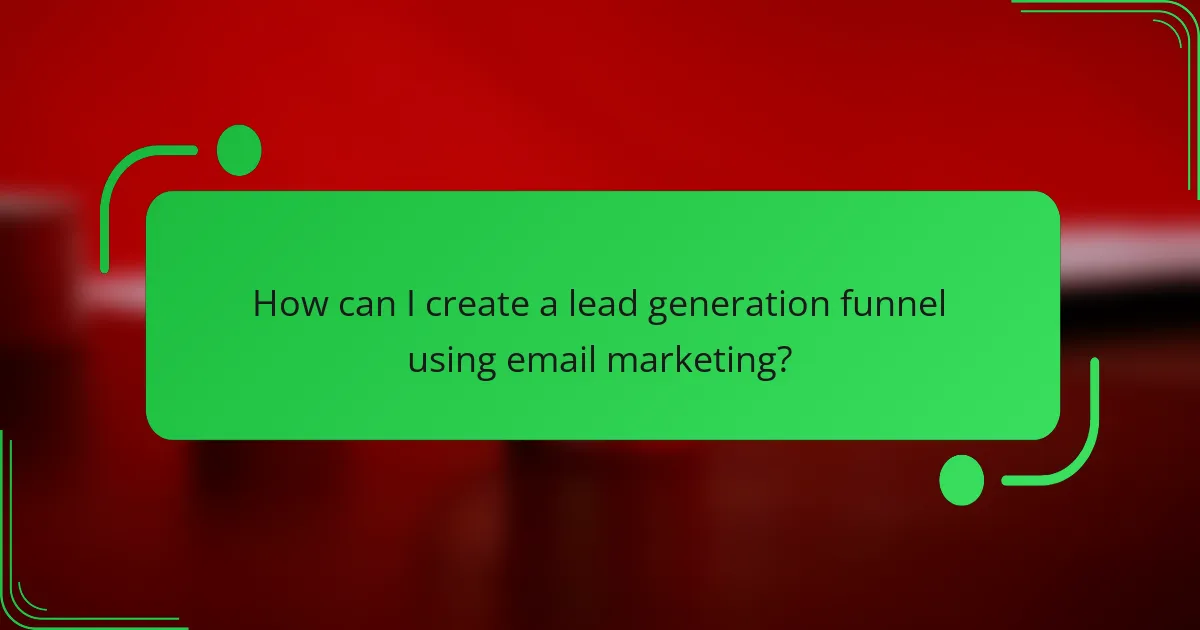
How can I create a lead generation funnel using email marketing?
Creating a lead generation funnel with email marketing involves attracting potential customers, engaging them, and converting them into paying clients. This process typically includes defining your target audience, developing lead magnets, designing effective landing pages, and implementing nurturing sequences.
Define target audience
Identifying your target audience is crucial for a successful lead generation funnel. Consider demographics such as age, location, interests, and purchasing behavior to tailor your messaging effectively. Use surveys or analytics tools to gather insights about your ideal customers.
Once you have a clear picture of your audience, segment them into groups based on shared characteristics. This allows for personalized email campaigns that resonate more deeply with each segment, increasing engagement and conversion rates.
Develop lead magnets
Lead magnets are incentives offered to potential customers in exchange for their contact information. Common examples include eBooks, whitepapers, webinars, or discount codes. The key is to ensure that the lead magnet provides genuine value to your audience.
When creating lead magnets, focus on solving a specific problem or addressing a pain point for your target audience. This not only attracts leads but also establishes your authority in the field, making prospects more likely to trust your brand.
Design landing pages
A well-designed landing page is essential for converting visitors into leads. It should be visually appealing, easy to navigate, and contain a clear call to action (CTA). Ensure that the landing page aligns with the lead magnet being offered to maintain consistency.
Incorporate elements such as testimonials, bullet points highlighting benefits, and a simple form to capture visitor information. A/B testing different designs can help you determine which elements drive the highest conversion rates.
Implement nurturing sequences
Nurturing sequences are automated email campaigns that engage leads over time, guiding them through the sales funnel. Start by sending a welcome email, followed by a series of informative messages that provide value and build trust.
Consider using a mix of educational content, product information, and personalized recommendations based on the lead’s behavior. Monitor engagement metrics to adjust your sequences and ensure they resonate with your audience, increasing the likelihood of conversion.
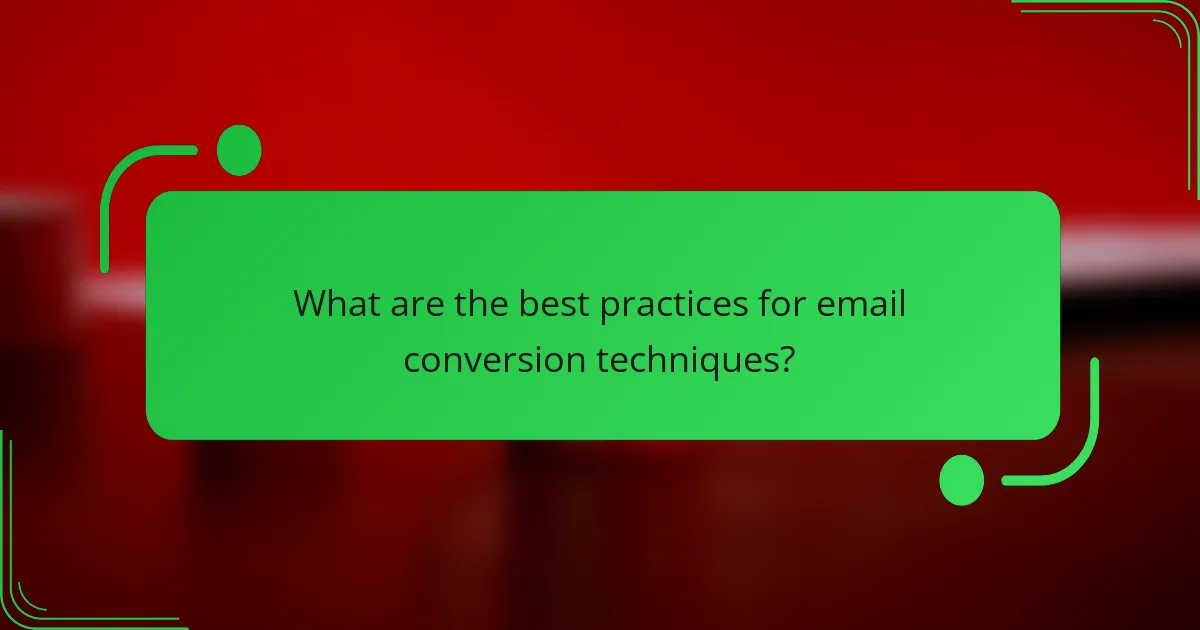
What are the best practices for email conversion techniques?
Effective email conversion techniques focus on optimizing the elements that encourage recipients to take action. By implementing strategies such as A/B testing, optimizing send times, leveraging social proof, and ensuring mobile-friendly designs, marketers can significantly enhance their email campaign performance.
A/B testing subject lines
A/B testing subject lines involves sending two variations of an email to different segments of your audience to determine which subject line generates higher open rates. Consider testing elements like length, tone, and personalization. For instance, a subject line with a question might perform better than a straightforward statement.
To conduct A/B testing effectively, ensure your sample size is large enough to yield statistically significant results. Aim for a testing period of a few days to account for different recipient behaviors, and analyze the results to inform future campaigns.
Optimizing send times
Optimizing send times can greatly impact email open and conversion rates. Research suggests that emails sent during weekdays, particularly Tuesday to Thursday, often see better engagement than those sent on weekends. However, the best time can vary based on your audience’s habits.
Utilize analytics tools to track when your audience is most active. Experiment with different send times, such as early morning or late afternoon, and monitor the results to identify patterns that lead to higher conversions.
Using social proof
Incorporating social proof in your emails can enhance credibility and encourage conversions. This can include testimonials, user reviews, or statistics showcasing how many customers have benefited from your product or service. For example, stating “Join over 10,000 satisfied customers” can create a sense of trust.
Make sure to present social proof visually appealing, such as including star ratings or customer photos. This not only captures attention but also reinforces the value of your offering.
Mobile-friendly designs
Creating mobile-friendly email designs is crucial, as a significant portion of users access emails on their smartphones. Ensure your emails are responsive, meaning they automatically adjust to fit various screen sizes. Use larger fonts and buttons to facilitate easy reading and clicking on mobile devices.
Test your emails on multiple devices before sending them out. Avoid excessive images and keep the layout simple to enhance load times and user experience. A well-optimized mobile design can lead to higher engagement and conversion rates.
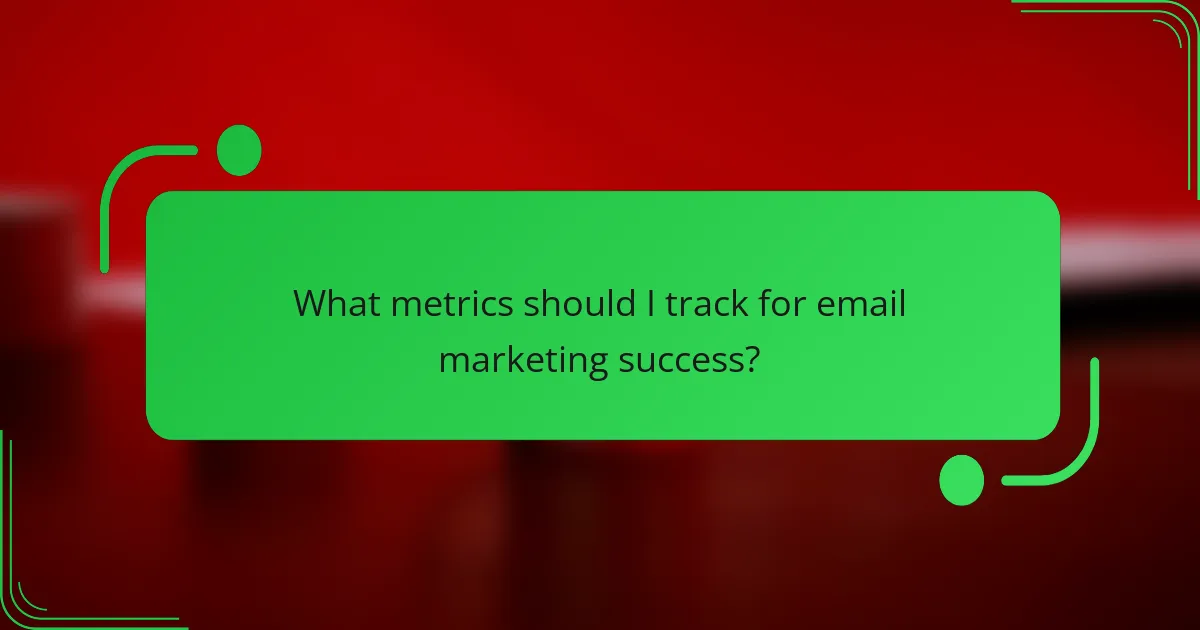
What metrics should I track for email marketing success?
To measure email marketing success, focus on key metrics such as open rates, click-through rates, conversion rates, and unsubscribe rates. Tracking these metrics helps you understand audience engagement and the effectiveness of your campaigns.
Open rates
Open rates indicate the percentage of recipients who opened your email. A typical open rate ranges from 15% to 25%, depending on the industry. To improve this metric, craft compelling subject lines and ensure your emails are mobile-friendly.
Consider segmenting your audience to send more targeted emails, which can lead to higher open rates. A/B testing different subject lines can also help identify what resonates best with your audience.
Click-through rates
Click-through rates (CTR) measure the percentage of recipients who clicked on one or more links in your email. A good CTR generally falls between 2% and 5%. To enhance this metric, use clear calls to action and engaging content that encourages interaction.
Utilizing buttons instead of text links can improve visibility and increase clicks. Additionally, consider personalizing your emails to make them more relevant to the recipient’s interests.
Conversion rates
Conversion rates reflect the percentage of recipients who completed a desired action, such as making a purchase or signing up for a webinar. Typical conversion rates can vary widely but often range from 1% to 5%. To boost conversions, ensure your landing pages are optimized and align with your email content.
Incorporate urgency or limited-time offers in your emails to encourage immediate action. Tracking the customer journey can also help identify where potential drop-offs occur, allowing for targeted improvements.
Unsubscribe rates
Unsubscribe rates indicate the percentage of recipients who opted out of your email list after receiving a campaign. A healthy unsubscribe rate is usually below 1%. To minimize this rate, provide valuable content and avoid overwhelming your audience with frequent emails.
Consider including a preference center where subscribers can choose the type and frequency of emails they receive. This approach can help retain subscribers who might otherwise opt out due to irrelevant content.
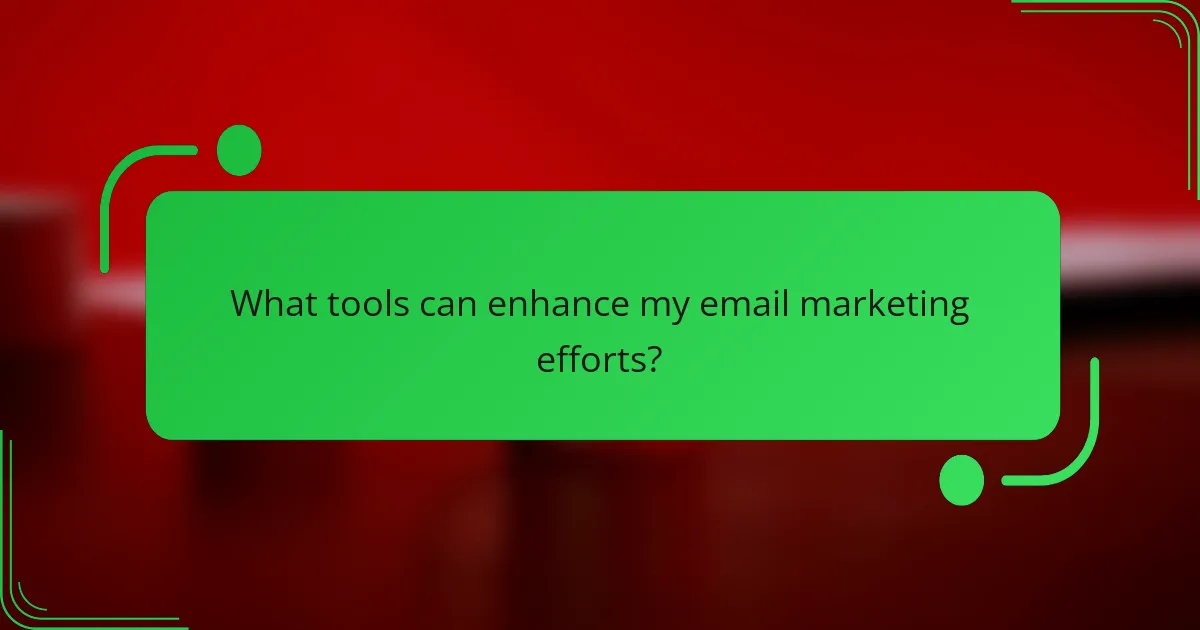
What tools can enhance my email marketing efforts?
Several tools can significantly improve your email marketing efforts by streamlining processes, enhancing automation, and providing valuable analytics. Choosing the right tools can lead to better lead generation funnels and higher conversion rates.
Mailchimp for automation
Mailchimp is a widely-used email marketing platform that excels in automation features. It allows users to set up automated email campaigns based on user behavior, such as welcome emails for new subscribers or follow-ups for abandoned carts.
To get started with Mailchimp, create an account and import your contact list. Use the automation builder to design workflows that trigger emails at specific times or actions. Consider segmenting your audience for more personalized messaging, which can improve engagement rates.
Be mindful of common pitfalls, such as over-automating and sending too many emails, which can lead to unsubscribes. Aim for a balance by monitoring engagement metrics and adjusting your strategy accordingly.
